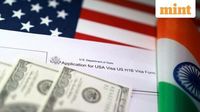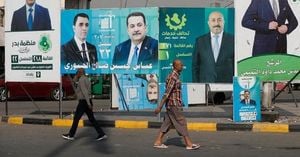President Donald Trump’s recent overhaul of the H-1B visa program, featuring a staggering $100,000 fee per new visa, is sending shockwaves through American universities, tech giants, and even the fashion and beauty industries. While the eye-watering fee has triggered widespread backlash and a high-profile lawsuit, its ripple effects are already being felt in classrooms, boardrooms, and HR departments across the country.
The new fee, set to hit companies when the annual H-1B lottery opens in March 2026, marks a dramatic jump from previous charges that ranged from $2,000 to $5,000, according to the American Immigration Council. But here’s the rub: universities and certain research or nonprofit organizations—though exempt from the annual lottery and cap—aren’t spared the new financial burden. They can apply for visas year-round, but they’ll still need to fork over the $100,000 fee for each new H-1B hire. As Jeremy Neufeld, director of immigration policy at the Institute for Progress, told the press, “The universities are on the frontlines and this is just a pure tax on their pipeline.”
For academic institutions, this isn’t just a budgeting headache—it’s a direct hit to their ability to attract and retain global talent. At Stanford University, which led all U.S. schools with 500 H-1B visas granted between October 2024 and June 2025, 36% of graduate students hail from abroad. Nearly half of graduate students at Washington University in St. Louis and Columbia University in New York City are international. These numbers aren’t just statistics; they represent the lifeblood of American innovation and research.
“One of the primary reasons why people come here as well is because of the international reputation of the American education system,” said Aisling Kelliher, an associate professor at the University of Southern California who originally arrived in the U.S. on an H-1B visa. “It’s a huge opportunity, both to come here as an immigrant and to receive an education, and then also to be able to continue as a researcher and as a teacher within the system that you’ve learned from.”
But the new policy is already causing confusion and anxiety. The University of Southern California (USC) issued a travel advisory on October 8, 2025, urging faculty and staff on H-1B visas to postpone international travel until further notice. The guidance, quoted by TOI, also advised those currently abroad to return to the U.S. before the new proclamation takes effect. “Out of an abundance of caution, all faculty and staff in H-1B status currently in the U.S. should put international travel plans on hold until they receive further guidance,” the statement read.
It’s not just academia feeling the pinch. The Business of Fashion identified 20 companies in the fashion and beauty sectors with at least 15 employees working on active H-1B visas as of June 30, 2025. Nike tops the list with over 260 H-1B employees, placing it alongside tech titans like eBay and Lucid Motors. Other affected companies include Gap Inc., American Eagle Outfitters, Levi Strauss, Nordstrom, Macy’s, Kohl’s, The Estée Lauder Companies, and Il Makiage. While many of these roles are in tech and data—think data scientists and engineers—there are plenty of creative positions too, from design directors to social media managers.
For big players like Nike, the new fee is significant but manageable. “Take Nike. If they had 17 new approvals last year, that’s $1.7 million,” Ben Johnston, chief operating officer of Kapitus Global, told Business of Fashion. “That’s not even a rounding error.” But for smaller fashion firms, the story is different. “A lot of times these fashion companies … don’t have the funds to pay that $100,000 fee overnight,” said immigration lawyer Shivani Honwad. “If you have a team of 10 people and you’re losing one to two people that have been integral to your company, this company is turned upside down.”
Some companies are already pulling job offers, and international candidates are scrambling to find alternatives. The O-1 visa, for individuals with “extraordinary abilities,” is an option, but it’s a much higher bar to clear. There’s also the L-1 visa for employees transferring within multinational companies. Still, as Honwad points out, “People that are on these visas are very accomplished. They have higher education. They have a special skill set and bring something to our communities and companies in the U.S. that others may not. These policies are impacting them. People like this are living in fear. Even if this policy isn’t technically kicking them out tomorrow, it’s putting them in a place where you’re curtailing the good they can do.”
The business community isn’t taking the change lying down. A coalition of universities, healthcare providers, and nonprofits filed a lawsuit on October 3, 2025, in the U.S. District Court for the Northern District of California, calling the $100,000 fee unlawful and economically damaging. The U.S. Chamber of Commerce also weighed in, warning that the policy would limit access to critical talent and force companies to outsource key functions. The lawsuit claims the government bypassed required rulemaking and failed to consider the harm to organizations reliant on H-1B professionals, from schools and hospitals to tech and manufacturing firms.
There’s also concern that the new measures could reshape hiring strategies, spike program costs, and accelerate a shift toward alternative visa categories and green card sponsorships. The chilling effect is already visible. Data from the U.S. International Trade Administration shows international student arrivals (excluding Canada and Mexico) were down 19% in August 2025 compared to the previous year, falling to 307,419. July arrivals dropped 28% to 76,519. Some of that dip, as noted by Forbes immigration contributor Stuart Anderson, may be due to students deciding not to risk leaving the U.S. for summer break, fearing they might not be allowed back in.
And the changes don’t stop with H-1B visas. The Trump administration’s September 2025 measures include a proposed lottery change that would prioritize older, higher-paid workers, potentially making it harder for international students with master’s and PhD degrees to stay and work after graduation. There are also proposed tweaks to student visas that could block some graduate students from pursuing postdoctoral roles through Optional Practical Training (OPT), a program that lets STEM graduates work in the U.S. for up to three years and often serves as a bridge to H-1B sponsorship.
Meanwhile, the administration’s broader immigration stance is hardening. Refugee admissions for FY2026 have been slashed to 7,500—a historic low—down from 125,000 under the Biden administration, with certain groups, such as white Afrikaners from South Africa, reportedly prioritized. The Supreme Court has also allowed the administration to proceed with ending Temporary Protected Status (TPS) for Venezuelan nationals, affecting hundreds of thousands. These moves signal a tightening of humanitarian and discretionary immigration pathways, leaving many immigrant communities and advocates deeply unsettled.
As the legal battle over the $100,000 H-1B fee heats up, universities, companies, and individuals are left in limbo—forced to weigh the cost of global talent against the realities of a shifting immigration landscape. For now, one thing is clear: the stakes are high, and the outcome will shape the future of American innovation, education, and industry for years to come.






